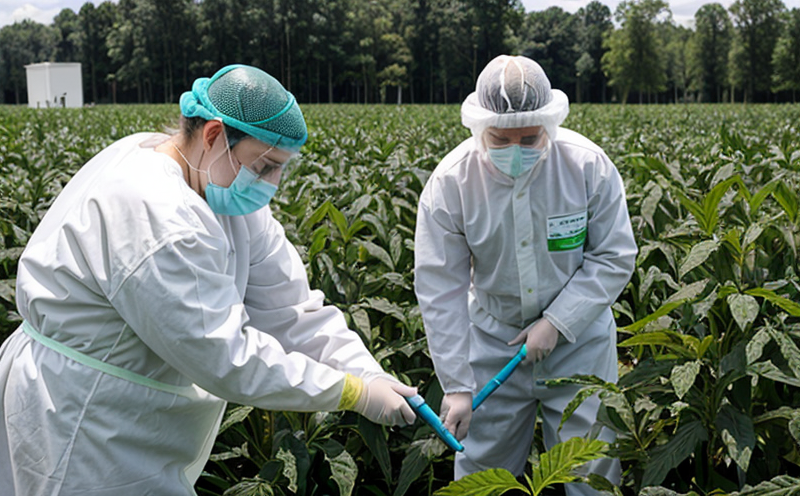AOAC Validation of Biocontrol Microorganism Detection Methods
The AOAC (Association of Official Analytical Chemists) validation process is a stringent and internationally recognized method for ensuring the accuracy, precision, and reliability of analytical methods used in food safety analysis. In the context of biocontrol agents and beneficial microorganisms, this service plays an essential role in validating detection methods that ensure these biological entities are correctly identified and quantified.
The validation process involves a series of rigorous tests designed to demonstrate that the method can consistently produce accurate results under specified conditions. This is crucial for ensuring compliance with regulatory requirements and maintaining product integrity, especially when dealing with biocontrol agents used in agriculture or food processing.
During AOAC validation, several key parameters are evaluated to ensure the robustness of a detection method:
- Linearity: The range over which the method can accurately quantify the target microorganism.
- Detection limit: The minimum concentration at which the method can reliably detect the presence of the biocontrol agent or beneficial microorganism.
- Precision: Reproducibility and repeatability of results under identical conditions.
- Specificity: Ability to differentiate between the target organism and potential false positives.
The AOAC validation process typically involves a series of steps, including method development, initial testing with reference samples, and peer review. This ensures that the detection method is not only accurate but also robust against common interferences and matrix effects found in real-world applications.
For biocontrol agents and beneficial microorganisms, the validation process must account for their unique characteristics. These organisms can vary significantly in size, shape, and metabolic activity, which can affect the accuracy of detection methods. The AOAC standards provide guidelines that help ensure these factors are adequately addressed during method development.
Once a method passes all validation criteria, it is considered suitable for use in regulatory compliance and product quality assurance. This process not only enhances confidence in the results but also facilitates smoother interactions with regulatory bodies like the FDA or USDA.
The importance of AOAC validation cannot be overstated, especially when dealing with biocontrol agents and beneficial microorganisms. These organisms play a critical role in agriculture and food safety, and any discrepancies in their detection can have significant economic and health implications. By ensuring that detection methods are validated according to these stringent standards, laboratories like ours provide peace of mind to clients and contribute to the overall quality and safety of agricultural products and processed foods.
Applied Standards
The AOAC validation process adheres strictly to internationally recognized standards such as ISO/IEC, ASTM, EN, IEC, and others. These standards provide the framework necessary for ensuring that methods are consistent with global best practices in analytical chemistry.
In addition to these general standards, specific guidelines provided by organizations like AOAC International play a crucial role in tailoring validation processes to meet sector-specific needs. For biocontrol agents and beneficial microorganisms, these guidelines help ensure that the validation process accounts for the unique characteristics of these organisms. This includes considerations such as variability in growth rates, potential interactions with other microorganisms, and environmental factors that can affect detection.
By adhering to these standards, laboratories like ours ensure that their methods are not only accurate but also reliable across a wide range of conditions and samples. This commitment to international best practices helps maintain the highest levels of quality and consistency in our services.
Scope and Methodology
The scope of AOAC validation for biocontrol microorganism detection methods encompasses a wide range of parameters that are critical to ensuring method accuracy, precision, and reliability. The primary focus is on validating the ability of the method to accurately detect and quantify biocontrol agents and beneficial microorganisms in various environmental and food processing samples.
The methodology involves several key steps:
- Method Development: This initial phase involves selecting appropriate media, incubation conditions, and detection techniques based on the characteristics of the target organisms.
- Reference Material Preparation: Standard reference materials are prepared to ensure consistency in testing.
- Initial Testing: The method is tested using a series of samples with known concentrations of the target organism to establish baseline performance metrics.
- Precision Studies: Reproducibility and repeatability of results are evaluated under various conditions to ensure consistent performance.
- Specificity Assessments: The method’s ability to differentiate between the target organism and potential false positives is tested.
The AOAC validation process also includes extensive documentation of all steps, results, and observations. This ensures transparency and reproducibility, which are critical for maintaining confidence in the method's performance.
Quality and Reliability Assurance
The quality and reliability assurance processes associated with AOAC validation are designed to ensure that every aspect of the testing procedure meets or exceeds international standards. This includes rigorous calibration, standardization, and quality control measures.
Calibration: All instruments used in the validation process are calibrated regularly to ensure accuracy. This is particularly important for methods that rely on precise measurements such as spectrophotometry or chromatography.
Standardization: Standard operating procedures (SOPs) are established and followed strictly to minimize variability in testing results. These SOPs cover everything from sample preparation to data analysis.
Data Quality Control: Data from each validation run is carefully reviewed for accuracy, precision, and consistency. Any discrepancies are investigated and corrected before final results are reported.
By maintaining high standards of quality and reliability, we ensure that the methods validated through this process can be trusted to provide accurate and reliable results. This commitment to excellence helps maintain confidence in our services and ensures compliance with regulatory requirements.





